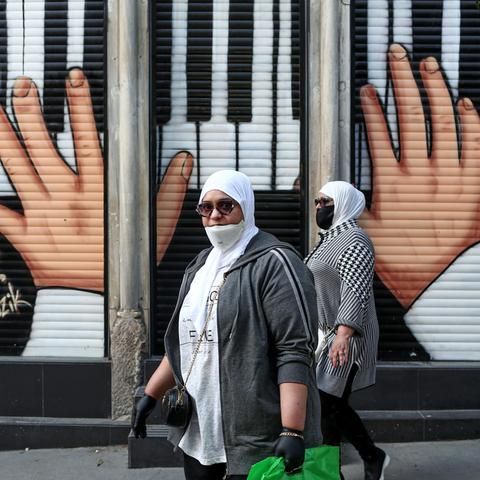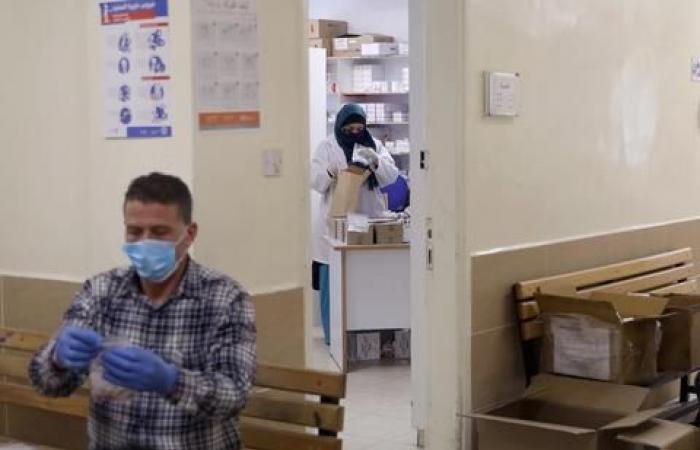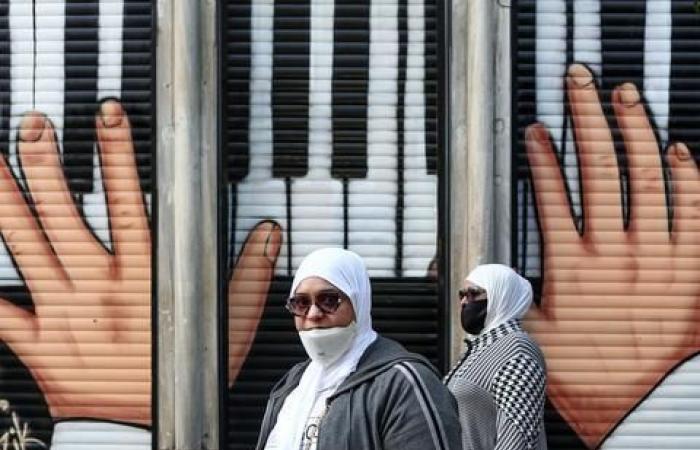Thank you for your reading and interest in the news How Jordan crushed the curve and halted Coronavirus in its tracks and now with details
Hind Al Soulia - Riyadh - As life in Jordan begins to return to something like normality after six weeks of intensive and targeted lockdowns, its swift measures has led new Covid-19 cases to plummet and protected its health system.
The numbers that have encouraged Jordan to ease its lockdown speak for themselves. Just 451 confirmed total cases, 350 full recoveries so far, 8 deaths and a daily new case count dropping to zero for three days as of Thursday.
Jordan is also conducting up to 3,000 random tests a day as well as systematic checking of those with symptoms or who have come into contact with confirmed infections.
Even as Health Minister Saad Al Jaber cautioned on Wednesday that a “stronger second wave could return,” Jordan has forged a unique model that has allowed the kingdom to snuff outbreaks early and resume normal life seemingly more quickly than many others.
Early on, Jordan’s lockdown was characterized by start-and-stops, trial and error as the country attempted to tailor a response that allowed citizens to get their basic needs but still isolate cases in a tiny kingdom of 10 million people where 95 per cent of the population live on 5 per cent of the available land.
Members of the medical staff at UNRWA prepare prescription medicines to deliver to Palestinian refugees in their homes at Amman New camp amid concerns over the spread of the coronavirus disease. Picture taken April 15, 2020. Reuters
A clothes shop owner wearing a protective faced mask is waiting for customers in Downtown Amman. EPA
Jordan has announced the reopening of shoes and textile stores from 26 April following strict rules. EPA
Jordanians started the holy month fasting in the context of the Covid-19 Coronavirus curfew on 24 April, they are allowed outside their homes only between 8pm and 6pm. EPA
A traditional dress shop keeper reads the Quran, on the second day of Muslim's holly month of Ramadan in Downtown Amman, Jordan. EPA
Two women walk past the deserted Roman Theatre, a landmark usually very crowded with people enjoying a visit of end of the day stroll, in Amman. EPA
Staff member of the UNRWA clinic of Al Wehdat Palestinian Refugee camp walks past a volunteer preparing medication to be delivered to patients. EPA
Some 57,000 registered refugees crowd its 0,48 KM Square and the arrival of the Covid-19 means that UNRWA had to adapt its methods to cater to the refugees needs especially for education and health within the limitations of a semi-curfew regime. EPA
A man flies a kite with the phrase "Stay at home" as part of an initiative launched by Jordan Kuwait Bank to support unemployed individuals and raise awareness against coronavirus disease. Reuters
People attend an Orthodox Easter Mass as the restrictions set to fight the spread of the coronavirus disease, at the Church of Mary of Nazareth in Amman on April 19. REUTERS
A Christian family observes Orthodox Easter Mass at home, watching television, as the restrictions are set to fight the spread of the coronavirus disease. Reuters
Abdullah from Sudan wears a face protective mask and protective gloves as he milks a camel in Amman. EPA
Abdullah from Sudan wearing a face protective mask and gloves accompanies camels in Amman. EPA
Palestinian refugees wait in front of the Al Wehdat camp health centre to register their names to get medication amid concerns over the spread of the coronavirus disease. Reuters
Palestinian refugees wait in front of the Al Wehdat camp health centre to register their names to get medication amid concerns over the spread of the coronavirus disease. Reuters
A staff member prepares to join his colleagues inside a Covid-19 triage tent at Al Bashir hospital in Amman. EPA

Jordan first declared a partial curfew on March 17 when it learned that an infected national arriving from Spain had attended a wedding of 400 people. Forget flattening the curve, from the onset Jordan looked to crush it.
The government immediately invoked an emergency powers defence law and announced a partial curfew and lockdown, closing schools, universities, commercial offices and non-essential government services, leaving only grocery stores, bakeries, butchers and pharmacies open.
At the National Center for Security and Crisis Management, the government, military, security services in coordination with the Royal Palace coordinated Jordan’s response, for the first time all sitting at the same table on a regular basis.
Yet after several days in which the public failed to abide by the partial-curfew, the government tightened further. On March 20 they declared a complete nationwide lockdown barring people from leaving their homes at all.
All restaurants and shops were shuttered, no deliveries, farms or factories could operate. The military was deployed to the streets; governorates and cities were cut off from one another.
Violators faced a year in prison.
The most basic tasks became dilemmas: Can people take out the rubbish? What if there is a medical emergency? How can citizens receive their salaries? What about day labourers?
The government deployed a team of ministers each night on national TV to field questions. At first, they stumbled in answering even basic problems posed by a worried public whose lives had suddenly been put on hold – and were quickly running out of basic goods.
A misfire programme to deliver bread by bus was met with hundreds crowding by deliveries, pushing, shoving and even fighting. Meanwhile, many towns and neighbourhoods saw no bread deliveries at all.
The government reached a middle ground: corner grocery shops and pharmacies could open. People were allowed to walk to their neighbourhood grocery shops and buy goods between 10am and 6pm before sirens blared and a night curfew was imposed.
In the first days, citizens were forced to line up for hours to enter cramped corner shops with narrow aisles where social distancing was difficult. Meat and poultry were at times impossible to get while the distribution of vegetables was poor.
The private sector voiced their frustration over unclear and changing regulations.
But then, something happened; a rhythm formed in the streets, in markets and inside Jordanian households.
And the measures appeared to be working. As daily Covid-19 cases began to drop to the single digits, the nightly government press conferences became calming rather than confusing. People began to see the curfew and measures with pride as a national project.
Meanwhile, the government took dozens of decisions ranging from health regulations at slaughterhouses to obliging employers to pay parts of workers’ wages and deploying mobile ATMs.
“The government in the first few weeks gained serious public trust and support due to its health measures, transparency and dealing with social consequences of the pandemic by extending donations and financial relief,” says Oraib Rantawi, director of the Amman-based Al Quds Centre for Political Studies.
Coronavirus around the Middle East
Women walk with face masks in Istanbul, Turkey. EPA
Shoppers wearing protective face mask to prevent the spread of the coronavirus at the Sharaf DG store at Mall of the Emirates in Dubai. Authorities ease the restriction for the residents in Dubai. At present mall opening timing is 12:00 pm to 10:00 pm. Carrefour timing is 9:00 am to 10:00 pm. Pawan Singh / The National
Shoppers wearing protective face mask to prevent the spread of the coronavirus at Mall of the Emirates in Dubai. Authorities ease the restriction for the residents in Dubai. At present mall opening timing is 12:00 pm to 10:00 pm. Carrefour timing is 9:00 am to 10:00 pm. Pawan Singh / The National
Shops and open-air markets are seen packed with people at southern Batha market after the Saudi government eased a curfew and allowed stores to open, following the outbreak of the coronavirus disease (COVID-19), in Riyadh, Saudi Arabia. REUTERS
A woman sits on a bench, during a countrywide lockdown to prevent the spread of the coronavirus disease (COVID-19) in Sidon, Lebanon. REUTERS
Amira Jamoussi, with a picture of herself pinned on her protective outfit to help others to recognise her, gets ready to see patients at the Abderrahmane Memmi hospital, where people infected by the COVID-19 caused by the novel coronavirus are being treated, in the city of Ariana north of the Tunisian capital Tunis. AFP
A man wears a protective face mask as he walks along the main market in downtown after the government eased the restrictions on movement aimed at containing the spread of the coronavirus disease (COVID-19), in Amman, Jordan. REUTERS
Selin Duygu Yucelen poses for a selfie in her room at a student dormitory where she is under a mandatory 14-day quarantine after returning from abroad, as part of the measures to prevent the spread of the coronavirus disease (COVID-19), in Bingol, Turkey. REUTERS
Selin Duygu Yucelen photographs her iftar meal at a student dormitory where she is under a mandatory 14-day quarantine after returning from abroad as part of the measures to prevent the spread of the coronavirus disease (COVID-19), in Bingol, Turkey. REUTERS
A truck for prevention against the COVID-19 coronavirus disease, operated by local NGO 'Violet Organization', drives through the streets of Idlib, Syria. EPA
A girl sells protective face masks and gloves at the main market in downtown after the government eased the restrictions on movement aimed at containing the spread of the coronavirus disease (COVID-19), in Amman, Jordan. REUTERS
A man wears a protective face mask while walking through a sanitizing gate, outside a factory, amid concerns over the coronavirus disease (COVID-19), in Cairo, Egypt. REUTERS
A woman wears a protective face mask, amid concerns over the coronavirus disease (COVID-19), in Cairo, Egypt. REUTERS
Chief physician Mohamed Besbes (L), Amira Jamoussi(R) and members of the medical staff surround a patient who recovered from the COVID-19, before being released from the Abderrahmane Memmi hospital, where people infected the novel coronavirus are being treated, in the city of Ariana north of the Tunisian capital Tunis. AFP
A man walks by closed shops in Algiers. Algeria eased confinement measures from the first day of the holy month of Ramadan last Friday by shortening a night curfew and lifting a full lockdown for a province near the capital Algiers. AP Photo
Men wearing face masks walk in Algiers. AP Photo
Boys play foosball table game, during a countrywide lockdown to prevent the spread of the coronavirus disease (COVID-19) in Sidon, Lebanon. REUTERS
People shop at a supermarket after the Saudi government eased a curfew and allowed stores to open, following the outbreak of coronavirus disease (COVID-19), in Riyadh, Saudi Arabia. REUTERS
A worker sprays disinfectant inside a mosque amid the ongoing coronavirus initiated COVID-19 pandemic in Sanaa, Yemen. EPA

“Today, Jordanians still rely on the nightly government press conferences for their news and information on this pandemic. This is an impressive success story.”
The true key to Jordan’s approach so far has been repetitive and random testing, case tracing and small localized “quarantines.”
Security services quarantined entire apartment buildings or neighbourhoods for weeks when multiple cases emerged there.
Any persons who mixed with confirmed cases were tested multiple times over two weeks; cutting off the governorates from each other allowed random testing to be an effective indicator of outbreaks.
Now beauty salons, speciality shops, dental clinics, law firms and some courts are reopening and half the kingdom can be back on the road – provided that social distancing and health measures are observed.
Yet just as Jordan reopens, it remains poised to shut everything down again at a moment’s notice – the very flexibility that has been the cornerstone of its early success.
“We are closely following citizens, facilities and shops levels of commitment to instructions in all governorates regarding social distancing, sanitizing and health protection measures,” government spokesman Amjaid Adaileh said at Wednesday’s daily briefing. He warned that “we could return to a comprehensive lockdown”
“When people sit back and look at this Coronavirus era, everyone should and will remember that Jordan was one of the few countries that was able to contain the pandemic in the very early stages and save lives,” says Mr Rantawi.
Updated: April 30, 2020 06:00 PM
These were the details of the news How Jordan crushed the curve and halted Coronavirus in its tracks for this day. We hope that we have succeeded by giving you the full details and information. To follow all our news, you can subscribe to the alerts system or to one of our different systems to provide you with all that is new.
It is also worth noting that the original news has been published and is available at The National and the editorial team at AlKhaleej Today has confirmed it and it has been modified, and it may have been completely transferred or quoted from it and you can read and follow this news from its main source.



